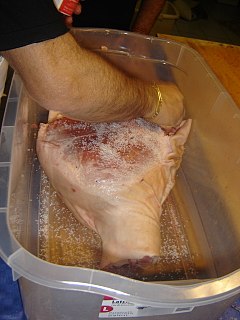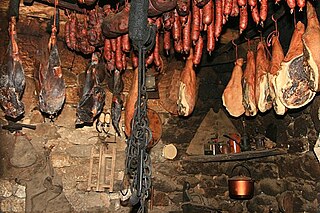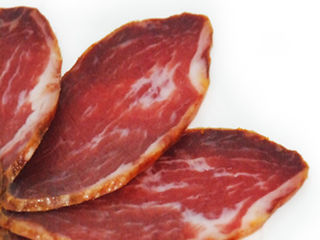
Ham is pork from a leg cut that has been preserved by wet or dry curing, with or without smoking. As a processed meat, the term "ham" includes both whole cuts of meat and ones that have been mechanically formed.
In food processing, brining is treating food with brine or coarse salt which preserves and seasons the food while enhancing tenderness and flavor with additions such as herbs, spices, sugar, caramel and/or vinegar. Meat and fish are typically brined for less than twenty-four hours while vegetables, cheeses and fruit are brined in a much longer process known as pickling. Brining is similar to marination, except that a marinade usually includes a significant amount of acid, such as vinegar or citrus juice. Brining is also similar to curing, which usually involves significantly drying the food, and is done over a much longer time period.

Smoking is the process of flavoring, browning, cooking, or preserving food by exposing it to smoke from burning or smoldering material, most often wood. Meat, fish, and lapsang souchong tea are often smoked.

Corned beef, or salt beef in the Commonwealth, is salt-cured brisket of beef. The term comes from the treatment of the meat with large-grained rock salt, also called "corns" of salt. Sometimes, sugar and spices are also added to corned beef recipes. Corned beef is featured as an ingredient in many cuisines.

Salting is the preservation of food with dry edible salt. It is related to pickling in general and more specifically to brining also known as fermenting and is one form of curing. It is one of the oldest methods of preserving food, and two historically significant salt-cured foods are salted fish and salt-cured meat. Vegetables such as runner beans and cabbage are also often preserved in this manner.
Smoked salmon is a preparation of salmon, typically a fillet that has been cured and hot or cold smoked.

Pastrami is a Romanian variant of the Turkish pastırma usually made from beef brisket, and sometimes from lamb, or turkey. The raw meat is brined, partially dried, seasoned with herbs and spices, then smoked and steamed. Like corned beef, pastrami was originally created as a way to preserve meat before the invention of refrigeration. One of the iconic meats of American Jewish cuisine and New York City cuisine, hot pastrami is typically served at delicatessens on sandwiches such as the pastrami on rye.

Smoked meat is the result of a method of preparing red meat, white meat, and seafood which originated in the Paleolithic Era. Smoking adds flavor, improves the appearance of meat through the Maillard reaction, and when combined with curing it preserves the meat. When meat is cured then cold-smoked, the smoke adds phenols and other chemicals that have an antimicrobial effect on the meat. Hot smoking has less impact on preservation and is primarily used for taste and to slow-cook the meat. Interest in barbecue and smoking is on the rise worldwide.

Pickling is the process of preserving or extending the shelf life of food by either anaerobic fermentation in brine or immersion in vinegar. The pickling procedure typically affects the food's texture and flavor. The resulting food is called a pickle, or, to prevent ambiguity, prefaced with pickled. Foods that are pickled include vegetables, fruits, meats, fish, dairy and eggs.

Cypriot cuisine is the culinary traditions and practices originating from Cyprus. It is heavily influenced by Arab, Greek and Turkish cuisines, whilst also sharing similarities with the cuisines of Italy and France

Charcuterie is a French term for a branch of cooking devoted to prepared meat products, such as bacon, ham, sausage, terrines, galantines, ballotines, pâtés, and confit, primarily from pork.

The following outline is provided as an overview of and topical guide to food preparation:

Smoked fish is fish that has been cured by smoking. Foods have been smoked by humans throughout history. Originally this was done as a preservative. In more recent times fish is readily preserved by refrigeration and freezing and the smoking of fish is generally done for the unique taste and flavour imparted by the smoking process.

Curing is any of various food preservation and flavoring processes of foods such as meat, fish and vegetables, by the addition of salt, with the aim of drawing moisture out of the food by the process of osmosis. Because curing increases the solute concentration in the food and hence decreases its water potential, the food becomes inhospitable for the microbe growth that causes food spoilage. Curing can be traced back to antiquity, and was the primary method of preserving meat and fish until the late-19th century. Dehydration was the earliest form of food curing. Many curing processes also involve smoking, spicing, cooking, or the addition of combinations of sugar, nitrate, and nitrite.

Cured fish is fish which has been cured by subjecting it to fermentation, pickling, smoking, or some combination of these before it is eaten. These food preservation processes can include adding salt, nitrates, nitrite or sugar, can involve smoking and flavoring the fish, and may include cooking it. The earliest form of curing fish was dehydration. Other methods, such as smoking fish or salt-curing also go back for thousands of years. The term "cure" is derived from the Latin curare, meaning to take care of. It was first recorded in reference to fish in 1743.

Salted fish, such as kippered herring or dried and salted cod, is fish cured with dry salt and thus preserved for later eating. Drying or salting, either with dry salt or with brine, was the only widely available method of preserving fish until the 19th century. Dried fish and salted fish are a staple of diets in the Caribbean, West Africa, North Africa, South Asia, Southeast Asia, Southern China, Scandinavia, parts of Canada including Newfoundland, coastal Russia, and in the Arctic. Like other salt-cured meats, it provides preserved animal protein even in the absence of refrigeration.

Cured pork tenderloin is found in various cuisines in Mediterranean Europe and South America. It is typically salted or brined then dry-cured or smoked.

















